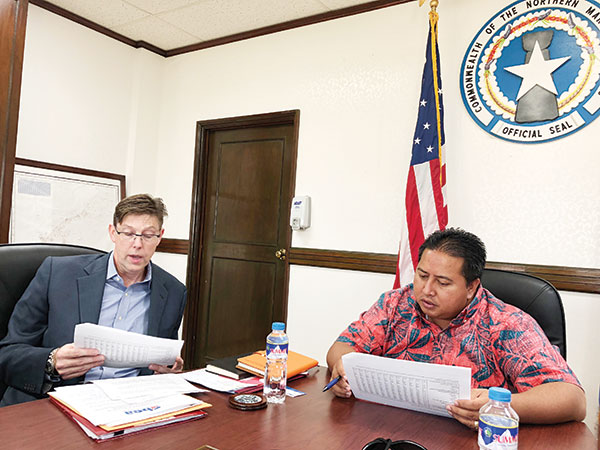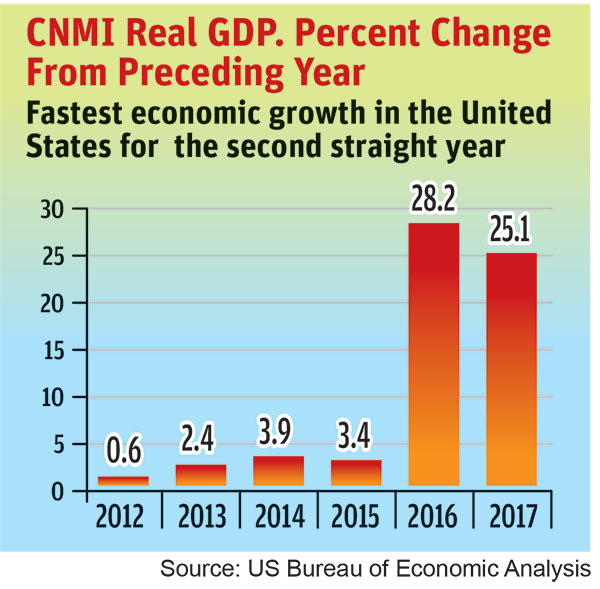‘NMI economy needs to diversify’

Gov. Ralph DLG. Torres, left, reviews the 2017 GDP estimates for the CNMI with Bureau of Economic Analysis director Brian C. Moyer on Thursday morning at the Office of the Governor. Others in the meeting were Secretary of Commerce Mark O. Rabauliman and staff of the CNMI Department of Commerce Central Statistics Division. (OFFICE OF THE GOVERNOR)
The administration of Gov. Ralph DLG Torres received good news yesterday about the robust 25.1-percent growth in the Commonwealth’s gross domestic product, as released by the U.S. Department of Commerce’s Bureau of Economic Analysis. That made the Commonwealth one of the fastest economies among U.S. states and territories for the second straight year.
Bank of Saipan president and CEO John Arroyo welcomed the news, but also cautioned the Commonwealth not to be overly reliant on a single industry and make an effort to attract other investors to sustain today’s progress.
“The 25.1-percent increase in GDP is still phenomenal and, from the CNMI’s perspective, is a huge increase, especially after coming out from the hard times brought by the closure of garment factories before,” Arroyo said in a telephone interview with Saipan Tribune yesterday.
The U.S. Department of Commerce’s BEA report said the CNMI economy grew by 25.1 percent in 2017 based on the gross domestic product estimates.
GDP is the measurement of the overall economic activity that includes private and public consumption, government outlays, investments, and construction costs while adding exports and subtracting the imports.
Arroyo said Imperial Pacific Resort’s casino operations was a major factor. “The injection of the new casino industry made a big difference and was a huge boost to the local economy. …We can also see its impact with the tourist numbers also going up, driven by the casino.”
“There’s also boom in real estate investments and the construction sector. There were a lot of renovations happening with existing properties and some are being improved to attract new tenants in the last two years that I’ve been on the island,” said Arroyo, who has also been with Bank of Hawaii.
Arroyo, who previously worked at Bank Pacific and also a former CEO of Guam credit union Coast 360, said there has been an increase in the cost of residential properties in general. “IPI has also been looking for properties for the housing of their employees and other staff. A lot are also driven by the low income and tax credits that are being made available.”
The 30-year veteran of the banking sector, however, cautioned that the CNMI must not rely on a single industry like the casino or tourism. “The CNMI economy’s growth depends on how well the casino does for the island. It is currently driven by a sole industry. This is how the CNMI’s economy is kind of being operated.”
“It will have a great effect in case the casino falters. Like the times of the garment industry, there’s no other industry to provide the economic boost going. Diversifying the economy is the way to sustain the economic gains. The government must look for other industries and investors to come in.”
BEA report
BEA director Brian C. Moyer said their report is based on revised estimates of GDP where the CNMI’s increased by 25.1 percent in 2017 after experiencing a 28.2-percent jump in 2016, making the Commonwealth one of the fastest economies among U.S. states and territories for the second straight year. “For comparison, real GDP for the U.S. (excluding territories) increased by 2.2 percent in 2017 after increasing 1.6 percent in 2016.”
BEA, in its report, said service exports were a huge factor in the CNMI economy’s growth as evident in the upward trend of tourist arrivals, thus the increase in visitor spending on the islands.
The increase in service exports offset the decline in private fixed investments, which went down by 8.9 percent after double-digit numbers for three consecutive years. Business spending on construction and other equipment remains high, helped in part by the ongoing construction of the Imperial Pacific Resort on Saipan.
BEA’s GDP estimates also showed the private sector being the source of the accommodations and amusement sector the largest contributor that reflected in the growth in tourism and the output of the casino industry.
“The compensation-by-industry estimates, measured in current dollars, show trends in compensation for major industries. Total compensation increased in 2016, reflecting increases in all sectors… The largest increase was in the accommodations and amusement sector,” the report said.
The report added that the estimates would be extended and improved following an agreement between the BEA and the Office of Insular Affairs. “The information provided by the CNMI government will continue to be critical to the successful production of these estimates.”
Mixed outlook
Small business owner Cecille Kamama sees a positive future for the CNMI with the improving economy, which would be felt slowly. “It’s like a chain reaction. We’ll soon feel the positive effects of this growth. You can see it with a lot of construction activity going on aside from the casino-hotel that’s being built.”
“But for our business, it is more reliant on locals and foreign workers. We’re not tourism-based. That’s why we can’t do any big expansion and we just keep the inventory that we have since it would have a big impact for us if the foreign workers would leave. We used to bring containers in shipping our goods, but we have to scale down due to the uncertainty with the foreign workers,” added Kamama, who owns Blue Haus in Garapan.
Another small business owner, who requested not to be named, said they had already felt the improving economy in 2016 due to the increase in their sales. “We have different markets here, mostly locals, but tourism is getting stronger.”
“Since September of this year, things are picking up and we are looking forward to higher sales in the coming months. The numbers are good on tourist arrivals from China and Korea, with Japan slowly picking up,” added the investor, who is part of a group that operates a bakeshop and restaurant.
But for Kris, a local employee who also asked for anonymity, the improving economy comes with a price. “The prices of basic commodities are rising and rent costs also increased. Hopefully, minimum wage earners like us would soon feel the effects of the economic boom.”
Local officials elated
Gov. Ralph DLG Torres led local officials that celebrated the report, saying that the CNMI economy had been experiencing five straight years of economic growth since 2012 and noted how far the Commonwealth had come.
“To go from where we were when our economy was declining every year since 2004 to where we are now, in which we see a 25.1 percent increase in 2017 and the fastest in the country for the second straight year is remarkable. This progress truly is a testament to the collaboration between the private sector, our government, and our entire community,” said Torres.
“Those dark days in our economy were not too long ago and I know we all remember those days. Our tourism industry was struggling with low arrival numbers, large and small businesses were struggling, rolling blackouts, but more importantly, many of our friends and families were struggling to make ends meet,” he added.
“But now we see an economy that has provided more opportunities for everyone. People now have more confidence to purchase and invest in things they want.”
Delegate Gregorio Kilili C. Sablan (Ind-MP) said the information provided by BEA is valuable since it gives government officials the feedback needed in shaping local policies and the public an idea of where the economy is going.
“One improvement would be to make these releases more real time. If we could move to more frequent, quarterly updates of GDP, then policy-makers here in the CNMI would be that much better equipped to manage the local government finances,” said Sablan.
Rep. Angel A. Demapan (R-Saipan), the House Ways and Means Committee chairman, said the CNMI’s economic growth gives the government an increase in resources for critical programs and services.
“The latest GDP report is a reaffirmation of the progress we have been seeing in the CNMI. To see such an exponential growth for the second straight year is very telling of what we can achieve when leadership is united and focused on the greater good,” said Demapan. “The data clearly tells us that the people of the CNMI are in a much better place today. This is definitely a direction that we want to sustain in the years to come.”
Commerce Secretary Mark Rabauliman said the CNMI’s economic growth is a testament of the administration’s economic agenda that also put forward small businesses, entrepreneurship, and the increased purchasing power of local residents.
Finance chief Larrisa Larson added the data given by BEA is the result of the hard work and collaboration by local officials, but their job is not yet done as they also need to secure the future of the CNMI’s next generation.
“These numbers are a reflection of the hard work and the collaboration of the administration and the Legislature to rebuild our economy and to sustain it for future generations to come. There is still a lot of work to do, but we are so excited to finally see the results of some very difficult but necessary decisions for our future.”




























